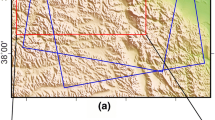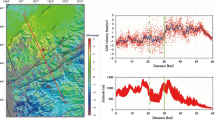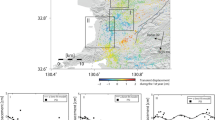Abstract
A strong earthquake of Mw 7.3 hit the border region between Iran and Iraq on November 12, 2017. Several InSAR-based coseismic inversion studies suggested that the earthquake occurred on a northeast dipping Mountain Front Fault within the Precambrian Arabian basement. In this study, we use multiple ascending and descending pass C-band Sentinel-1 images to study the earthquake's pre- and post-seismic surface displacements. We performed SBAS time series from June 2017 to March 2018 to understand the spatiotemporal evolution of the displacement before and after the November event. The pre-seismic time series displacement values range as high as –89 mm in descending pass and –96 mm in ascending pass. The pre-seismic time series analysis reveals subsidence between 84 and 0 days before the earthquake, which might be due to excessive groundwater pumping. The post-seismic displacements showed logarithmic decay, indicating afterslip. Even though the earthquake occurred on a blind reverse fault, we highlight that the post-seismic afterslip is composed of horizontal and vertical deformation components, which can be inferred from the variation in the displacement values of the descending and ascending passes. We believe that the small magnitude earthquakes and the January 2018 Mandali earthquake sequence in the Zagros Mountain region affect the spatiotemporal evolution of the November event afterslip.
Research Highlights
-
The temporal evolution of the pre-seismic displacement indicates significant ground subsidence before the earthquake.
-
The pre-seismic ground subsidence due to excessive groundwater withdrawal combined with the interseismic strain accumulation might result in a reverse faulting earthquake.
-
The results highlight the importance of the multi-temporal InSAR technique in the field of earthquake precursory studies.
-
Several small magnitude earthquakes and the Mandali earthquake sequence that occurred after the earthquake affected the temporal evolution of the post-seismic afterslip.
-
The pre-seismic deformation is dominantly vertical, whereas the post-seismic deformation is a combination of horizontal and vertical motion.







Similar content being viewed by others
References
Barnhart W D, Brengman C M, Li S and Peterson K E 2018 Ramp-flat basement structures of the Zagros Mountains inferred from coseismic slip and afterslip of the 2017 Mw 7.3 Darbandikhan Iran/Iraq earthquake; Earth Planet. Sci. Lett. 496 96–107.
Berardino P, Fornaro G, Lanari R and Sansosti E 2002 A new algorithm for surface deformation monitoring based on small baseline differential SAR interferograms; IEEE Trans. Geosci. Remote Sens. 40(11) 2375–2383.
Chatterjee R S, Fruneau B, Rudant J P, Roy P S, Frison P L, Lakhera R C, Dadhwal V K and Saha R 2006 Subsidence of Kolkata (Calcutta) City India during the 1990s as observed from space by differential synthetic aperture radar interferometry (D-InSAR) technique; Remote Sens. Environ. 102 176–185.
Crosetto M, Monserrat O, Cuevas-González M, Devanthéry N and Crippa B 2016 Persistent scatterer interferometry: A review; ISPRS J. Photogramm. Remote Sens. 115 78–89.
Devaraj S, Yarrakula K, Martha T R, Murugesan G P, Vaka D S, Surampudi S, Wadhwa A, Loganathan P and Budamala V 2022 Time series SAR interferometry approach for landslide identification in mountainous areas of Western Ghats India; J. Earth Syst. Sci. 131 133.
Ding K, He P, Wen Y, Chen Y, Wang D, Li S and Wang Q 2018 The 2017 Mw 7.3 Ezgeleh Iran earthquake determined from InSAR measurements and teleseismic waveforms; Geophys. J. Int. 215(3) 1728–1738.
Dong S, Samsonov S, Yin H and Huang L 2018 Two-dimensional ground deformation monitoring in Shanghai based on SBAS and MSBAS InSAR methods; J. Earth Sci. 29 960–968.
Dwivedi R, Narayan A B, Tiwari A, Dikshit O and Singh A K 2016 Multi-temporal SAR interferometry for landslide monitoring; Int. Arch. Photogramm. Remote Sens. Spat. Inf. Sci. XLI-BB 55–58.
Feng W, Samsonov S, Almeida R, Yassaghi A, Li J, Qiu Q, Li P and Zheng W 2018 Geodetic constraints of the 2017 Mw 7.3 Sarpol Zahab Iran earthquake and its implications on the structure and mechanics of the north-west Zagros thrust-fold belt; Geophys. Res. Lett. 45(14) 6853–6861.
Hooper A, Bekaert D, Spaans K and Arıkan M 2012 Recent advances in SAR interferometry time series analysis for measuring crustal deformation; Tectonophys. 514 1–13.
Ittycheria N, Vaka D S and Rao Y S 2018 Time series analysis of surface deformation of Bengaluru city using Sentinel-1 images; ISPRS Ann. Photogramm. Remote Sens. Spat. Inf. Sci. IV–5 473–477.
Janalipour M, Abbaszadeh Tehrani N, Mohammad Khanlu H, Khesali E and Enayati H 2019 Rapid damage mapping after an earthquake using Sentinel-2 images (case study: Sarpol-e Zahab); Environ. Manag. Hazards 6 131–148.
Kim J, Kim D-J, Kim S-W, Won J-S and Moon W M 2007 Monitoring of urban land surface subsidence using PSInSAR; Geosci. J. 11 59–73.
Kobayashi T, Morishita Y, Yarai H and Fujiwara S 2018 InSAR-derived crustal deformation and reverse fault motion of the 2017 Iran–Iraq Earthquake in the northwestern part of the Zagros Orogenic Belt; Bull. Geospatial Inf. Auth. Jpn. 66.
Kuang J, Ge L, Metternicht G I, Ng AH-M, Wang H, Zare M and Kamranzad F 2018 Coseismic deformation and source model of the 12 November 2017 Mw 7.3 Kermanshah Earthquake (Iran–Iraq border) investigated through DInSAR measurements; Int. J. Remote Sens. 40(2) 532–554.
Kumar L R, Vaka D S and Rao Y S 2018 Mapping Land Subsidence of Krishna–Godavari Basin using Persistent Scatterer Interferometry Technique; 38th Asian Conf. Remote Sens. 4 2490.
Kumar S, Kumar D, Chaudhary S K, Singh N and Malik K K 2020 Land subsidence mapping and monitoring using modified persistent scatterer interferometric synthetic aperture radar in Jharia Coalfield India; J. Earth Syst. Sci. 129(1) 146.
Kundu B, Vissa N K, Gahalaut K, Gahalaut V K, Panda D and Malik K 2019 Influence of anthropogenic groundwater pumping on the 2017 November 12 M 7.3 Iran–Iraq border earthquake; Geophys J. Int. 218 833–839.
Lal P, Vaka D S and Rao Y S 2018 Mapping surface flow velocities of Siachen and Gangotri glaciers using TerraSAR-X and Sentinel-1A data by intensity tracking; ISPRS Ann. Photogramm. Remote Sens. Spat. Inf. Sci. IV–5 325–329.
Liu G X, Ding X L, Li Z L, Li Z W, Chen Y Q and Yu S B 2004 Pre- and coseismic ground deformations of the 1999 Chi-Chi Taiwan earthquake measured with SAR interferometry; Comput. Geosci. 30 333–343.
Lohman R B and Simons M 2005 Locations of selected small earthquakes in the Zagros mountains; Geochem. Geophys. Geosyst. 6(3).
Moro M, Saroli M, Stramondo S, Bignami C, Albano M, Falcucci E, Gori S, Doglioni C, Polcari M and Tallini M 2017 New insights into earthquake precursors from InSAR; Sci. Rep. 7(1) 1–11.
Osmanoğlu B, Sunar F, Wdowinski S and Cabral-Cano E 2016 Time series analysis of InSAR data: Methods and trends; ISPRS J. Photogramm. Remote Sens. 115 90–102.
Peltzer G, Rosen P, Rogez F and Hudnut K 1996 Postseismic rebound in fault step-overs caused by pore fluid flow; Science 273 1202–1204.
Rao Y S, Venkataraman G, Rao K S and Snehmani 2004 SAR interferometry for DEM generation and movement of Indian glaciers; IGARSS 2004-2004 IEEE International Geoscience and Remote Sensing Symposium 2 1128–1131.
Sandwell D, Mellors R, Tong X, Wei M and Wessel P 2011 Open radar interferometry software for mapping surface deformation; Eos Trans. Am. Geophys. Union 92 234–234.
Schmidt D A and Bürgmann R 2003 Time-dependent land uplift and subsidence in the Santa Clara valley California from a large interferometric synthetic aperture radar data set; J. Geophys. Res. Solid Earth 108(B9).
Schmidt D A and Bürgmann R 2006 InSAR constraints on the source parameters of the 2001 Bhuj earthquake; Geophys. Res. Lett. 33(2).
Stramondo S, Moro M, Doumaz F and Cinti F R 2005 The 26 December 2003 Bam Iran earthquake: Surface displacement from Envisat ASAR interferometry; Int J. Remote Sens. 26 1027–1034.
Tavani S, Parente M, Puzone F, Corradetti A, Gharabeigli G, Valinejad M, Morsalnejad D and Mazzoli S 2018 The seismogenic fault system of the 2017, Mw 7.3 Iran–Iraq earthquake: Constraints from surface and subsurface data cross-section balancing and restoration; Solid Earth. 9(3) 821–831.
Taymaz T, Nilfouroushan F, Yolsal-Çevikbilen S and Eken T 2018 Coseismic crustal deformation of the 12 November 2017 Mw 7.4 Sar-Pol-Zahab (Iran) Earthquake: Integration of analysis based on DInSAR and seismological observations; EGU General Assembly Conference Abstracts 2018, 4186p.
Tymofyeyeva E and Fialko Y 2015 Mitigation of atmospheric phase delays in InSAR data with application to the eastern California shear zone; J. Geophys. Res. Solid Earth 120 5952–5963.
USGS 2017 M7.3 – 29 km S of Halabjah Iraq; https://earthquake.usgs.gov/earthquakes/eventpage/us2000bmcg/executive.
Utkucu M 2017 Preliminary seismological report on the November 12, 2017 Northern Iraq/Western Iran earthquake; Sakarya University, https://doi.org/10.13140/RG.2.2.17781.27364.
Vajedian S, Motagh M, Mousavi Z, Motaghi K, Fielding E J, Akbari B, Wetzel H-U and Darabi A 2018 Coseismic deformation field of the Mw 7.3 12 November, 2017 Sarpol-e Zahab (Iran) earthquake: A decoupling horizon in the northern Zagros Mountains inferred from InSAR observations; Remote Sens. 10(10) 1589.
Vaka D S and Rao Y S 2018 Deformation of Bhuj Earthquake area obtained with persistent scatterer interferometric analysis of ALOS L-Band SAR data; IGARSS 2018-2018 IEEE International Geoscience and Remote Sensing Symposium, pp. 513–516.
Vaka D S, Rao Y and Bhattacharya A 2019 Surface displacements of the 12 November, 2017 Iran–Iraq Earthquake derived using SAR Interferometry; Geocarto Int. 36(6) 660–675.
Vaka D S, Rao Y S and Singh T 2020 Surface deformation of the 2019 Mirpur earthquake estimated from Sentinel-1 InSAR data; 2020 IEEE India Geoscience and Remote Sensing Symposium (InGARSS), pp. 130–133.
Walker R T, Andalibi M J, Gheitanchi M R, Jackson J A, Karegar S and Priestley K 2005 Seismological and field observations from the 1990 November 6 Furg (Hormozgan) earthquake: A rare case of surface rupture in the Zagros mountains of Iran; Geophys. J. Int. 163 567–579.
Walpersdorf A, Hatzfeld D, Nankali H, Tavakoli F, Nilforoushan F, Tatar M, Vernant P, Chéry J and Masson F 2006 Difference in the GPS deformation pattern of North and Central Zagros (Iran); Geophys. J. Int. 167 1077–1088.
Wright T, Parsons B and Fielding E 2001 Measurement of interseismic strain accumulation across the North Anatolian Fault by satellite radar interferometry; Geophys. Res. Lett. 28 2117–2120.
Yang Y, Hu J, Yassaghi A, Tsai M, Zare M, Chen Q, Wang Z, Rajabi A M and Kamranzad F 2018 Midcrustal thrusting and vertical deformation partitioning constraint by 2017 Mw 7.3 Sarpol Zahab Earthquake in Zagros Mountain Belt Iran; Seismol. Res. Lett. 89(6) 2204–2213.
Yang C, Han B, Zhao C, Du J, Zhang D and Zhu S 2019 Co-and post-seismic deformation mechanisms of the Mw 7.3 Iran earthquake (2017) revealed by Sentinel-1 InSAR observations; Remote Sens. 11(4) 418.
Zare M, Kamranzad F, Parcharidis I and Tsironi V 2017 Preliminary report of Mw 7.3 Sarpol-e Zahab Iran earthquake on November 12 2017; EMSC Report 1(10).
Acknowledgements
We thank the European Space Agency (ESA) for providing Sentinel-1 data through the Copernicus Open Access Hub. SRTM elevation data is downloaded from Earth Explorer and provided by the National Aeronautics and Space Administration (NASA).
Author information
Authors and Affiliations
Contributions
D S Vaka processed the data, analysed the results, written and revised the manuscript. Y S Rao and A Bhattacharya supervised the work, discussed the results, and commented on the manuscript.
Corresponding author
Additional information
Communicated by Anand Joshi
Rights and permissions
About this article
Cite this article
Vaka, D.S., Rao, Y.S. & Bhattacharya, A. Time series analysis of the pre-seismic and post-seismic surface deformation of the 2017 Iran–Iraq earthquake derived from Sentinel-1 InSAR data. J Earth Syst Sci 132, 64 (2023). https://doi.org/10.1007/s12040-023-02085-2
Received:
Revised:
Accepted:
Published:
DOI: https://doi.org/10.1007/s12040-023-02085-2




